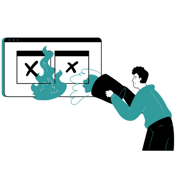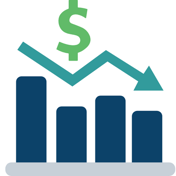The Hidden Costs of Manual Sales Incentive Planning
Incentive planning in spreadsheets might seem like a more affordable option since it doesn't require an additional software purchase, but realistically, the opportunity costs of error, time, and inefficiency will add up and could end up costing you a lot more than software licenses would. Sales compensation plans are often one of the top expenses for an organization, which is all the more reason to make sure the plans are set up properly & are configured accurately to achieve the best results.
Transitioning sales incentive plans from spreadsheet management into a software system will require some upfront work, but the rewards and ROI attached to this kind of project are immediately available for sales reps and leadership. Let's go through a few of the major costs you can expect when you're using manual processes for incentive compensation planning.
Error & Risk Prone
Spreadsheets are prone to errors. Human errors, technology errors, and a total loss of work and progress are all common practices when working with spreadsheets. These errors can also lead to compensation managers making risky choices without the proper knowledge and understanding of what those choices could mean in the future should the current state of the business change. We have seen compensation plan designs made through spreadsheet analysis that led to a decrease in top-line growth and a miss on target revenues because the compensation managers couldn't run "what-if" analyses before making costly changes. Don't believe just us on that though, here are just a few numbers you could probably relate to:
are all common practices when working with spreadsheets. These errors can also lead to compensation managers making risky choices without the proper knowledge and understanding of what those choices could mean in the future should the current state of the business change. We have seen compensation plan designs made through spreadsheet analysis that led to a decrease in top-line growth and a miss on target revenues because the compensation managers couldn't run "what-if" analyses before making costly changes. Don't believe just us on that though, here are just a few numbers you could probably relate to:
- 88% of all spreadsheets contain errors *1
- 83% of Fortune 2000 companies make errors in paying commissions accurately *2
- 85% of Fortune 2000 companies use spreadsheets to manage sales compensation *2
Sales Productivity Losses
Most incentive compensation plans suffer from a lack of transparency. In some cases, the unclear plans can be partially due to being overly complex, but in most cases, the most common reason for this lack of transparency is due to the inability to accurately communicate this plan information because of manual requirements. When working with manual processes, your reps aren't able to get the correct information regarding their compensation in a timely manner.
requirements. When working with manual processes, your reps aren't able to get the correct information regarding their compensation in a timely manner.
The average sales rep spends about 64% of their working hours on non-selling activities, which leaves only 36% of their time to dedicate to selling. *3 The more time your reps spend trying to calculate their commissions, the less time they will have available to actually be selling.
Undesirable Attrition
Sales organizations target about 10% turnover rates, but salesperson turnover rates can be up to 3x as high. A common frustration for someone focused on selling is an unclear compensation plan. The largest frustration, however, comes when there are errors with the sales reps' plans and payouts. There are many ways to try to keep attrition rates low - and in today's market, working with software and gaining skills is always a plus. Even compensation managers are looking to continue building skills that will be applicable in the future. Implementing new software helps keep employees engaged with the ability to continue learning, and it also helps to attract new talent.
frustration, however, comes when there are errors with the sales reps' plans and payouts. There are many ways to try to keep attrition rates low - and in today's market, working with software and gaining skills is always a plus. Even compensation managers are looking to continue building skills that will be applicable in the future. Implementing new software helps keep employees engaged with the ability to continue learning, and it also helps to attract new talent.
Organizations have a lot of factors and costs to consider when it comes to turnover:
- The typical ramping time for an enterprise AE is between 12 to 18 months
- U.S firms spend $15 billion a year training salespeople *4
To get some insight into the outcomes after these manual processes are retired and more automated processes are implemented, read how Voiant helped PerkinElmer leverage data management to decrease their dependency on excel use and increase transparency.
Contact us to Learn How Much Your Team is Spending on Manual Incentive Processes.
References
1. MarketWatch: University of Hawaii IT Management study on bad spreadsheet practices
2. 2018 Sales Compensation Administration Best Practices Survey
3. Forbes: Why Sales Reps Spend Less Than 36% of Time Selling
4. HBR How to Predict Turnover on Your Sales Team July-Aug 2017
